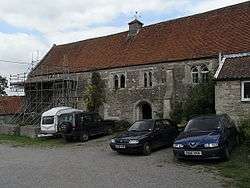Robert Willoughby, 1st Baron Willoughby de Broke





Robert Willoughby, 1st Baron Willoughby de Broke, de jure 9th Baron Latimer (c. 1452 – 23 August 1502), KG, of Brook (anciently "Broke"), in the parish of Heywood, near Westbury in Wiltshire, was one of the chief commanders of the royal forces of King Henry VII against the Cornish Rebellion of 1497.[1]
Origins
Robert Willoughby was born at Brook (anciently "Broke"), his father's estate then in the parish of Westbury, Wiltshire, now in the later parish of Heywood. He was the son of Sir John Willoughby of the family of the Barons Willoughby of Eresby, seated at Eresby Manor near Spilsby, Lincolnshire. His mother was Anne Cheney, 2nd daughter and co-heiress of Sir Edmund Cheyne (died 1430) of Brook, by his wife Alice Stafford, daughter of Sir Humphrey Stafford of Hooke, and an aunt of Humphrey Stafford, 1st Earl of Devon (died 1469). Edmund Cheyne was the eldest son and heir of Sir Ralph Cheyne (c. 1337–1400) of Poyntington in Somerset and of Brook (three times a Member of Parliament for Wiltshire, Deputy Justiciar of Ireland, Lord Chancellor of Ireland, and Deputy Warden of the Cinque Ports) by his wife Joan Pavely, daughter & co-heiress of Sir John Pavely of Brook.[3]
Career
He was High Sheriff of Cornwall in 1479 and High Sheriff of Devon in 1480. He was Lord of the Manor of Callington and steward of the Duchy of Cornwall.[1]

The barony of Willoughby de Broke, named after the manor of Brooke/Broke, Heywood, near Westbury, Wiltshire, was created when Robert Willoughby was summoned to Parliament by writ in 1492. On his death on 23 August 1502 the title passed to his eldest son Robert Willoughby, 2nd Baron Willoughby de Broke.[4]
He died at the manor house of Callington, for he directed in his will that he should be buried in the church of the parish he died in.
Marriage & progeny
He married in 1472 Blanche (or Joan[5]) Champernowne, daughter and heiress of John Champernowne of Bere Ferrers, Devon, by Elizabeth Bigbury. John was the son of Alexander Champernowne of Modbury and Joan Ferrers, da. of Martyn Ferrers of Bere Ferrers. He thus acquired the manors of Callington, Cornwall. and Bere Ferrers amongst others.
He had four children with Blanche:[6]
- Robert Willoughby, 2nd Baron Willoughby de Broke (d.1521). Predeceased by his son and heir Edward, whereupon the title became abeyant in 1521 between Edward's three daughters and was terminated around 1535, when daughter Elizabeth became sole heiress. Buried at Bere Ferrers.[7]
- Elizabeth, who married firstly John Dynham, 1st Baron Dynham, and secondly William FitzAlan, 18th Earl of Arundel.
- John (died young)
- Anthony (died young)
Sources
- Hamilton Rogers, W.H., The Strife of the Roses & Days of the Tudors in the West, Exeter, 1890, "Our Steward of Household", Robert, Lord Willoughby de Broke, K.G., pp.1-37
on-line text, freefictionbookson-line text, with images, Project Gutenburg
Further reading
- Hamilton Rogers, William Henry The Ancient Sepulchral Effigies and Monumental and Memorial Sculpture of Devon, Exeter, 1877, pp. 346–7 & Appendix 3, pedigree of Willoughby de Broke.
- Leigh Rayment's Peerage Pages – Peerages beginning with "W" (part 2) "Wellesley to Willoughby of Parham".
- Lundy, Darryl (3 June 2008). "Robert Willoughby, 1st Baron Willoughby de Broke". The Peerage.
- Baron Willoughby of Broke from Crofts Peerage.
References
- 1 2 3 Rogers, p.346
- ↑ Mis-drawn and mis-blazoned by Rogers as a cross engrailed. The Bere Ferrers bench ends, where perhaps the wood disallows great detail in carving, shows not a cross crosslet but rather a thick plain cross.
- ↑ History of Parliament: House of Commons, 1386–1421, vol. 2, Stroud, 1992, Cheyne, Sir Ralph, pp. 554–555
- ↑ Cokayne Complete Peerage
- ↑ Rogers, Appendix 3
- ↑ Cokayne Complete Peerage
- ↑ Rogers, p.346, quoting "Lysons"
| Political offices | ||
|---|---|---|
| Preceded by The Lord FitzWalter |
Lord Steward 1488–1502 |
Succeeded by The Earl of Shrewsbury |
| Peerage of England | ||
| New creation | Baron Willoughby de Broke 1492–1502 |
Succeeded by Robert Willoughby |